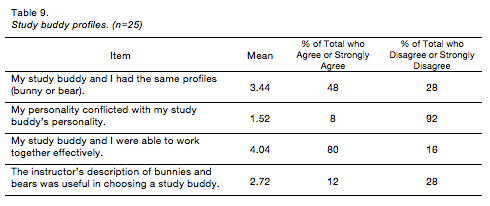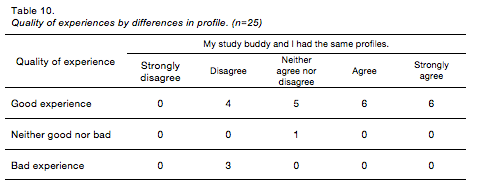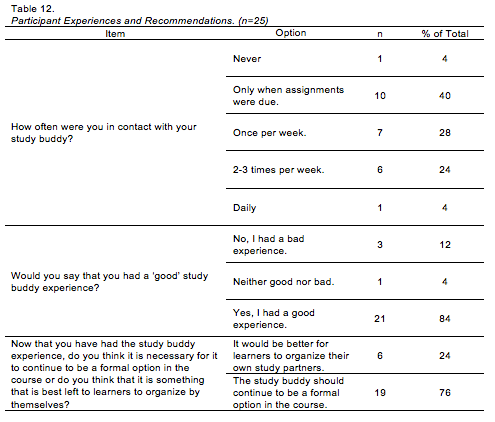As a cooperative learning activity, does the study buddy activity provide sufficient scaffolding to promote deep approaches to learning?
The second research question was reflective of the exploratory nature of the study in that there was no expectation of a difference between any of the four classes of participant groups in the study. Consequently, data were described rather than compared.
A key structural component of the study buddy activity is the description that the instructor uses to characterize different types of students. Richards (personal communication, n.d.) uses “bunnies” to describe those students who typically prefer to get their work done early and “bears” to describe those who usually finish their work at the last minute. He recommends that bunnies pair with bunnies and bears pair with bears to avoid the conflicts that may arise in a partnership with one who wants to complete the work early and the other who procrastinates and pushes the work to the deadline.
A summary of the data related to mix of bunnies and bears in this study is displayed in Table 8.
Data were gathered in a manner that could not have indicated whether learners who identified as bears also preferred to work on their own, or if the cohorts from which these participants were recruited were more densely populated with bunnies, or if online graduate students are typically more bunny-ish than other populations. All three of these possibilities have implications for future research into the study buddy activity.
Data were gathered to explore the characteristics of the study buddy pairs and whether or not participants found the “bunny-bear” characterization to be helpful. These data are summarized in Table 9.
The importance of partner compatibility was an interesting theme recurring throughout the quantitative and qualitative findings. Of the three participants who described themselves as “more of a bear” (Table 8), all three indicated that their partner had a different profile than their own, yet only one of the three reported having a bad experience in the study buddy activity.
Three participants reported having a bad experience with the study buddy activity (Table 10), and all three had partners with different profiles, however, there were another four who reported having a good experience while their partners had a different profile. Furthermore, one of the participants who had a bad experience reported that their partner suddenly disengaged from the activity without notification (it was later learned that the partner who disappeared did so for medical reasons).
The findings were inconclusive on the question of the utility of the “bunny-bear” characterization and whether it was important for participants to have a similar partner. Indeed, only three (12%) of the participants indicated that the “bunny-bear” characterization was helpful. More than twice as many participants (n=7; 28%) disagreed that the characterization was helpful, and most (n=15; 60%) were ambivalent about the value of the characterization.
A key difference between asynchronous online and face-to-face learning environments is the greater need for clear, concise instructions in an asynchronous online environment. When an instructor is not physically or temporally present to answer questions about the details of an activity, it is incumbent upon the designer of the learning materials to ensure that the instructions for any activity are easy for the learners to understand. Table 11 summarizes the data with respect to the ease with which study buddy participants were able to understand the requirements and to engage with the activity.
The findings indicate that the instructions for the study buddy activity were easy to follow and clear enough to allow potential participants to predict the amount of time the activity would require. The very high levels of reported effectiveness and willingness to participate again indicate that the study buddy participants were satisfied with the benefits they received for the work they put into the study buddy activity.
It is noteworthy that those who chose to not participate in the study buddy activity (Table 15) felt more strongly that the instructions were easy to understand (n=6; mean rating=4.17) than those who participated (n=25; mean rating=3.8). Non-participants appeared to have decided against participating in the activity primarily because they thought that the activity would take too much of their time.
With only three (12%) participants having reported a low quality experience with the study buddy activity, this investigation cannot answer the question of whether the number of times study buddy partners were in contact is an indicator of the quality of the experience. However, more than half (n=14; 56%) of the participants reported that they were in contact with their study buddy partner at least once per week (Table 12). With a total of four course assignments that were a part of the study buddy activity, this number is noticeably higher, both in the number of participants and the frequency of communication, than those who were in contact with their partner only when assignments were due.
The idea that the frequency of interactions is a good sign is supported by the fact that 84% (n=21) of participants in the study indicated that they had a good experience throughout the study buddy activity. This finding was also supported in the qualitative analysis. As noted previously, the three participants who reported having a bad experience all had study buddy partners with a different profile. The one participant who reported that the experience was neither good nor bad had a partner who completely failed to engage in the process.
A clear majority of participants in this study (76%) reported that they thought that the study buddy should remain a formal part of the course, while the remaining 24% felt that potential participants should be allowed to form partnerships on their own terms (Table 12).
In retrospect, this question should not have been presented with a binary response; a third option should have been presented that allowed participants to indicate that they would recommend that the study buddy not be a part of the course at all. However, when participants were asked later in the survey whether or not they would recommend the study buddy activity for other students in other courses, only one of 18 participants who answered that question (6%) indicated that they would not recommend the activity.




